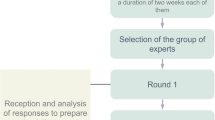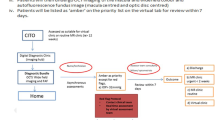Abstract
Purpose of study Visible disfigurement is associated with a range of psychosocial difficulties; however, the problems encountered by patients with eye conditions are under-researched. This study aimed to establish the extent and type of psychosocial distress in this patient population, and to explore the extent to which patients' needs are currently met.
Method Standardised measures (anxiety, depression, appearance-related distress, and quality of life) and a semistructured interview (exploring individual experiences and satisfaction with care) were administered to 153 consecutive attenders at outpatient eye clinics in three different hospitals. Responses were analysed using descriptive statistics, multiple regression, and cluster analyses.
Results Between 10 and 49% of the patient sample scored unfavourably on standardised measures in comparison with normative values. Cluster analyses revealed that more distressed patients typically exhibited higher levels of anxiety, depression, social anxiety, self-consciousness, and social avoidance. Quality of life scores were also less favourable. Distressed patients felt less well informed, less involved in their treatment, and less well supported in the clinic setting. Variability within the sample was high; however, the effects of the cause and duration of the condition were not significantly related to distress. Clinic staff identified a variety of constraints to meeting patients' need, including patient numbers, the lack of appropriate training, and the lack of referral possibilities.
Conclusions A considerable proportion of patients with disfiguring eye conditions experience high levels of psychosocial distress. Several options exist for ways in which patients' needs might more effectively be met within the constraints currently facing care providers.
Similar content being viewed by others
Log in or create a free account to read this content
Gain free access to this article, as well as selected content from this journal and more on nature.com
or
References
McGrouther DA . Facial disfigurement: the last bastion of discrimination. BMJ 1997; 314: 991.
Lansdown R, Rumsey N, Bradbury E, Carr T, Partridge J (eds). Visibly Different: Coping with Disfigurement. Butterworth Heinemann: London, 1997.
Hart P, Chakravarthy U, Stevenson M . Questionnaire based survey on the importance of quality of life measures in Ophthalmic practice. Eye 1998; 12: 124–126.
Frewin SE, Dickinson AJ, Kendall Taylor P, Perros P . Thyroid eye disease. Newslett Thyroid Eye Dis Assoc 1999; 45: 8–11.
Moss TP . Individual differences in psychological adjustment to perceived abnormalities of appearance. Unpublished PhD thesis, University of Plymouth, 1997.
Clarke AC . Psychosocial aspects of facial disfigurement: problems management and the role of a lay-led organisation. Psychol Health Med 1999; 4(2): 127–142.
Carr T . Assessment and measurement in clinical practice. In: Lansdown R, Rumsey N, Bradbury E, Carr T, Partridge. J (eds). Visibly Different: Coping with Disfigurement. Butterworth Heinemann: London, 1997, pp 131–146.
Zigmond AS, Snaith RP . The Hospital Anxiety & Depression Scale. Acta Psychiatr Scand 1983; 67: 361–370.
Moss TP . Individual variation in adjusting to visible differences. In: Lansdown R, Rumsey N, Bradbury E, Carr T, Partridge J (eds). Visibly Different: Coping with Disfigurement. Butterworth Heinemann: London, 1997, pp 121–130.
The WHOQOL Group. Development of the World Health Organisation WHOQOL-Bref Quality of Life Assessment. Psychol Med 1998; 28: 551–558.
Clarke A, Cooper C . Psychosocial rehabilitation after disfiguring injury or disease; investigating the training needs of specialist nurses. J Adv Nurs 2001; 34(7): 18–26.
Acknowledgements
This work was carried out in the Out-Patient Departments of the Moorfields Eye Hospital, London; The Bristol Eye Hospital & The Artificial Eye Centre, Bristol. The authors wish to acknowledge the help and support offered by staff at these centres, the contribution made to data collection by Veronica Kish, and the statistical expertise provided by Dr Paul White, Faculty of Computing, Statistics & Mathematics, University of the West of England, Bristol, UK. This research was funded jointly by The Nuffield Trust & The King's Fund.
Author information
Authors and Affiliations
Corresponding author
Rights and permissions
About this article
Cite this article
Clarke, A., Rumsey, N., Collin, J. et al. Psychosocial distress associated with disfiguring eye conditions. Eye 17, 35–40 (2003). https://doi.org/10.1038/sj.eye.6700234
Received:
Accepted:
Published:
Issue date:
DOI: https://doi.org/10.1038/sj.eye.6700234
Keywords
This article is cited by
-
Vismodegib improves quality of life in patients with periocular locally advanced basal cell carcinoma: subgroup analysis, STEVIE trial
Eye (2022)
-
Questionnaire study to gain an insight into the manufacturing and fitting process of artificial eyes in children: an ocularist perspective
International Ophthalmology (2017)
-
The psychological well-being and appearance concerns of patients presenting with ptosis
Eye (2014)
-
Appearance concerns in ophthalmic patients
Eye (2011)



